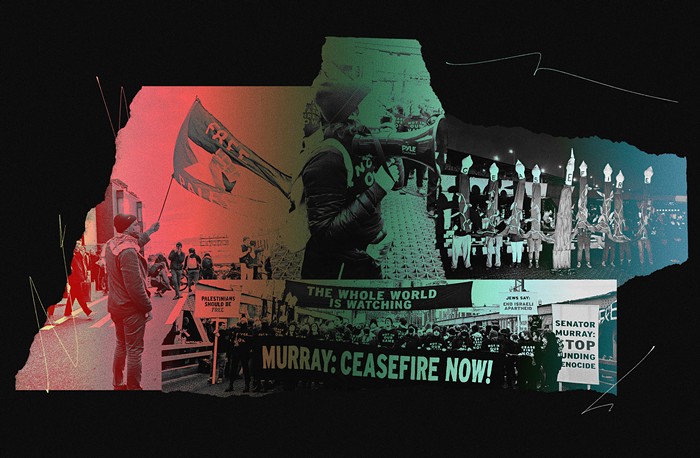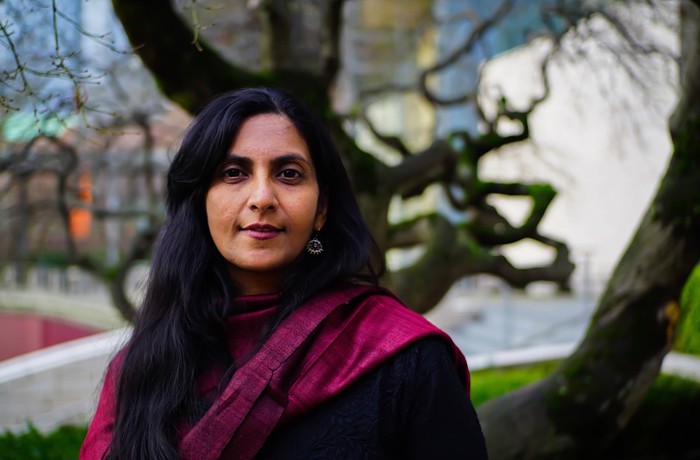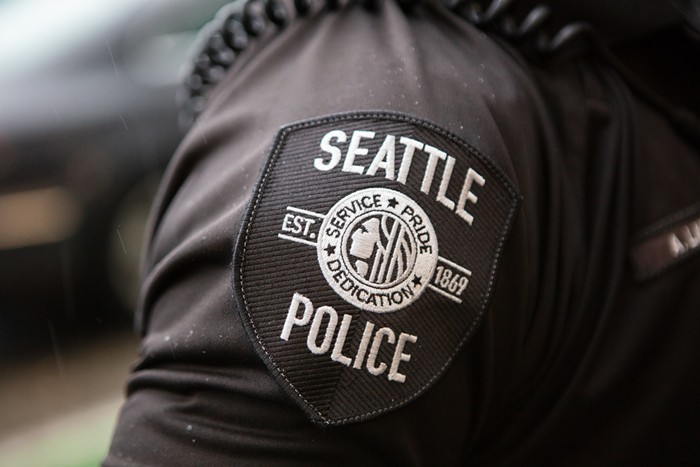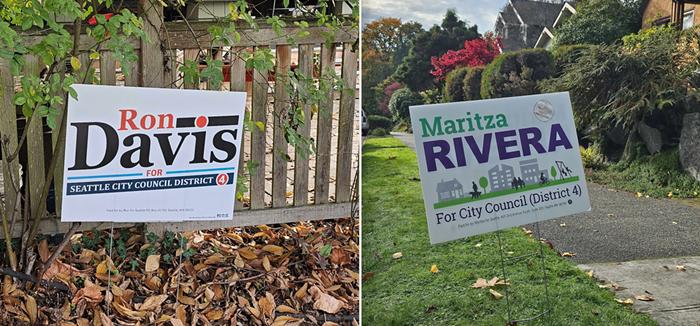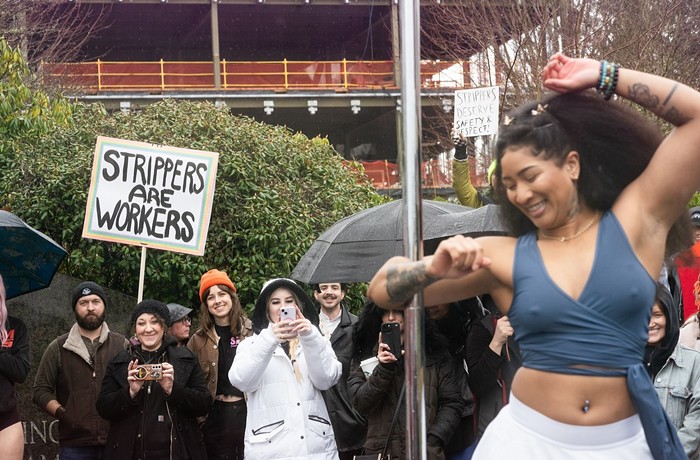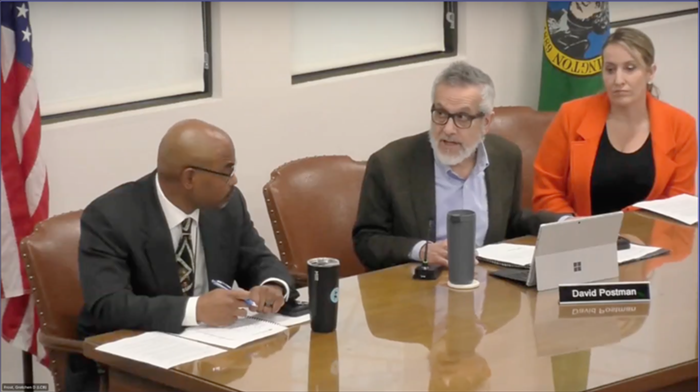In this task, she refuses to pander to touchy-feely rules about art. "My approach is to assume that an audience exists for intelligent, diverse work, and start from that angle," she told me. "What I hear a lot of, and have been guilty of in the past, is this sort of arts crusade, you know, we have to bring art to the masses. I'd rather assume the value of the work and the intelligence of the audience instead of shoving something down their throats and saying, 'I'm going to educate you, I'm going to enlighten you.'"
The first exhibition Kurtz curated for SPACE proved that she could hold up her end of the bargain. Project 18, in which eight artists were invited to make site-specific sculptures in and around Sand Point's Building 18, was a sophisticated look at claiming land for art, in this case a building that SPACE will renovate and turn into artist studios and exhibition space, as soon as the funds are raised.
Kurtz's ideas are inversely, even perversely, proportionate to the obstacles she faces. Sand Point Magnuson Park, formerly the Naval Station Puget Sound, is reached by a long, rather lonely road about five miles outside downtown Seattle. Buses are infrequent, and there are no shortcuts. Many people--artists, arts administrators, theater groups, cultural critics--distrust the idea of art at Sand Point largely because of its location. It's certainly true that every time I've visited Sand Point in the last 10 years, it's felt like a ghost town. There have been some very good exhibitions there, such as HorseHead in 1999, and Project 18 last year, but there never seems to be much life in the campus streets--just a few drifting custodial types, empty parking lots, and piles of debris.
Can Sand Point overcome its physical remoteness?
VITAL, DIVERSE, WILD
Naval Station Puget Sound once occupied the knob of former wetland jutting out into Lake Washington, from the Pontiac Bay shoreline on the north end to Northeast 64th Street on the south. The runway that slashed the point diagonally in half ran from northwest to southeast and mimicked the natural runway that shorebirds have always used. Airfield activity ceased at Naval Station Puget Sound in 1970, and after the 1990 Defense Base Closure Realignment Act, the area was declared surplus. In 1995, all military operations at Naval Station Puget Sound ceased. A long parade of planning meetings, task forces, and community discussions followed, all toward the development, refinement, and adoption of a reuse plan for the area, now called Sand Point Magnuson Park. There was a lot of input to consider: what the city wanted, what the neighbors wanted, what local tribes wanted, and, not least, the requirements of the federal government.
The terms of the contract that transferred 347 acres of land from the U.S. Navy to the city of Seattle (with 14 acres going to the Western Regional Center of the National Oceanic and Atmospheric Administration) specified that the mixed-use area include low-income housing and facilities for education and social services, in addition to venues for cultural activities and the park itself. Some of this is already happening: There's an operating Montessori school, and six buildings (including two former admirals' houses) serve as transitional housing for the homeless. Plans are underway for a branch of the Seattle Public Library, art and architecture studios for UW graduate students, new ballfields with grandstands, and a community center built in the old brig. The wetlands will be restored, and will serve as drainage for the ballfields and a new off-leash dog park.
The bulk of the transformation won't happen anytime soon. Eric Friedli, Sand Point's director of operations and planning, estimates that $150 million will be necessary to execute the most current park plan. This money will come, in part, from the parks levy voters approved in 2000, as well as from nonprofit groups such as SPACE, which can fundraise on the park's behalf. (The park's other resident nonprofits--Magnuson Community Gardens and various environmental groups--do not raise money for property development.) And then there's the Environmental Impact Statement: the process is due to begin this summer with a public comment period, which will no doubt generate more obstacles (the EIS for a former military base in San Francisco drew over 4,000 comments). The park won't be completed for at least 10 years.
C. David Hughbanks, Sand Point's executive director (who has since retired, after this article was written), is proud of this project. When he took me on an ambling guided tour of the park roads in his handsome old Mustang, he showed me each building, talked about future plans, and paused to admire the sweep of land from the parking lot to the lake. When we stopped to let an elderly couple stroll past, he said, "There are people who have been walking here since the '70s. I like to call them the ambient pioneers of the park." He's pleased that the rash of crime predicted by the park's neighbors--on account of the homeless housing--never happened. In fact, the housing, along with graduate student studios and the presence of artists and schoolchildren, means that Sand Point will be one of the few truly socially diverse neighborhoods in Seattle. It's hard not to fall for his vision of Sand Point--vital, diverse, a little bit wild.
ART IN CITIES
Sand Point's conversion follows a significant trend in current cultural planning in cities: the conversion of former military installations into mixed-use facilities for public benefit. It's been done successfully, by most accounts, at California's Marin Headlands, and at the Presidio in San Francisco.
Seattle Parks and Recreation oversees Sand Point, with former Seattle Arts Commission executive director Wendy Ceccherelli in the position of arts strategist. SPACE, which was created in 1992 (with the help of Allied Arts of Seattle) as an advocate for arts and culture during the park's reuse planning phase, functions as the parks department's nonprofit partner. Its role has changed over the years, from a kind of marketing organization, trying to attract performance groups, to a resource for those groups. Current and ongoing efforts involve Building 18, and it's even possible that SPACE may have a hand in future programming.
For now, any theater group can rent any available space for a production, but most of these spaces are quite raw and require intensive work, from rewiring to building floors. The truth is, there's great freedom in putting up a production in a place with few restrictions. (The lack of rules, in fact, has contributed to a kind of freewheeling creativity about making art in unlikely spaces, such as cavernous hangars, or the brig.)
The flip side of this freedom has been a tangle of bureaucracy. The Department of Construction and Land Use hasn't vetted each building, and the possibilities for violations seem endless. In 2001, Theater Simple was unpleasantly surprised when a city electrician happened to come across some jury-rigged wiring; their production would have been closed down had they not called in a professional electrician, at their own expense, to bring the building into compliance.
But it's really Sand Point's location that continues to put people off, even though most of the theater groups I spoke with were surprised that they could still draw audiences to productions not in Capitol Hill. And it is a surprise, even though other cities have proven that culture builds audiences. Queens was never a fashionable New York destination until the presence of P.S. 1 began to draw visitors. MASS MOCA, an excellent contemporary art space, is in North Adams, Massachusetts, 130 miles from Boston. Hughbanks attributes "Seattle's geographic dyslexia" to "an ingrained attitude about where things are, and should be." And he's right: What kind of culture do you get when you kowtow to convenience?
But there's more to it. Embedded in the resistance to Sand Point is a rumbling fear about the future of arts in cities.
THE DESTINATION
Recently I did a little investigation.
According to a January 9 article in the Wall Street Journal, Chicago is bequeathing underused, city-owned buildings to arts groups (such as the Joffrey Ballet, when it relocated from New York) and helping those groups finance redevelopment. These are not fair-weather gifts, to be rescinded when the economy perks up; they are permanent--unlike, for example, the Pioneer Square space that King County pulled out from under the now-defunct Project 416. Chicago has acted on something that a lot of other cities pay lip service to, namely that artists improve neighborhoods and create communities. This is something that local billionaire Paul Allen understands, which is why he leased the enormous and prominently placed former Ducky's building to Consolidated Works at below market rate.
I found that the city of Seattle isn't in any position to make such gifts, since it doesn't own anywhere near the number of empty spaces that Chicago does. The list of city-owned vacant properties (supplied to me by the Fleets and Facilities office) has only four commercial spaces, and two of these are former power substations. (Seattle's power stations are paved-over yards that give off ominous buzzing noises.) Another available space, the pergola site at the end of Washington Street on Alaskan Way, is slated for historic preservation. The last candidate is an old Safeway in Ballard--an expansive 20,000 square feet of space--which, as it turns out, has a number of enterprises bidding for its temporary use before it's demolished two years from now to make way for a new Ballard park.
But why is it, when artists grumble about how little the city does to provide for its artists, that the enormous spaces at Sand Point go unmentioned? Some artists seem to hold on to an outdated dream about the places they ought to inhabit--they would prefer big, north-facing lofts in the center of big, built-up cities, the kinds of spaces that were widely available in the mid-20th century, when de-industrialization and white flight emptied city centers. Those spaces are no longer available, having been turned into trendy work and living spaces, made trendy in some part (although not all) by artists themselves. It's a story that feels old because it has happened so often--artists move into a down-and-out neighborhood and are then booted out by more affluent people in search of the Bohemian lifestyle. Artists are running out of down-and-out neighborhoods to colonize in American cities.
The reality is that artists who wait for someone to give them lofts and theaters and cooperative gallery spaces in city centers are kidding themselves. City centers are no longer "for" artists and their low-income, multi-zoning needs. SoHo and TriBeCa in New York are prohibitively expensive; here in Seattle, Capitol Hill is increasingly off-limits, and no doubt Georgetown eventually will be too. This new economic reality is moving culture from the center of the American city to its periphery. The places making bids for artists these days are places some artists have a hard time picturing themselves in, places such as Tacoma (where a few visual artists I know, who show frequently in Seattle, have enormous, relatively cheap studios) and Bremerton.
And places like Sand Point.
In an e-mail to artist Matthew Lennon (who now lives in Ireland), I asked whether or not Sand Point had been a favorable place for HorseHead, the sculpture festival he curated until 1999. "The innate problem with Sand Point," he wrote back, "is that it is event-oriented. I always said that HorseHead was a laboratory for the visual arts.... This was, and remains, the model I believe necessary to manifest dynamic community planning: cities being cultural labs as opposed to consumer venues.... The city, organizations like SPACE, [and] community committees have very little vision or guts for such elements. They want packages, venues which can easily be swept away, quantified, and forgotten."
So for Sand Point, a more significant problem than location may be the distinction between art as a destination or final product, and art as an ongoing exchange of ideas. Don't artists need to be in a dynamic community setting, such as downtown Seattle, to work and thrive?
One thing I noticed as Hughbanks gave me his guided tour of Sand Point was that there wasn't any place for down time, no space to attract artists who aren't specifically granted studio space or working on a production. It's like one of those intentional communities or gated neighborhoods, where idiosyncrasies and accidents are ironed out, and only residents are welcomed. I have found there's a great deal of truth to the "third place" argument (the necessity of a good café or low-priced cafeteria for public interaction), since most independent minds reject overweening organization; the best artist communities are often distinctly unintentional.
It is not as small an objection as it seems. Art thrives on the accidents of people and ideas meeting, the guerrilla impulses that arise from hanging around and shooting the shit. You can't mandate art simply by designating space for it; such places tend to be oxygen-free, self-referential, precious. And nothing in Sand Point's plan encourages the laboratory. It is all about destination.
At one point, Hughbanks told me he envisioned Sand Point as a place much like Seattle Center. This, I think, would be fatal. Seattle Center has a dead feeling to it, a kind of obligatory civic gesture toward something called "arts" that has nothing to do with art and everything to do with civics. This seems to arise from the faulty conception that an arts community is not a place where ideas are exchanged but one where culture is consumed. But this doesn't seem to worry Hughbanks, nor did it worry Ceccherelli.
"I think Sand Point is going to be more experimental, more innovative, more cutting-edge," Ceccherelli told me, "with smaller performance groups that are attracted to the raw, unfinished spaces. It will attract younger, hipper crowds, and creative new talent.
"And besides," she said, "we have plentiful free parking."
